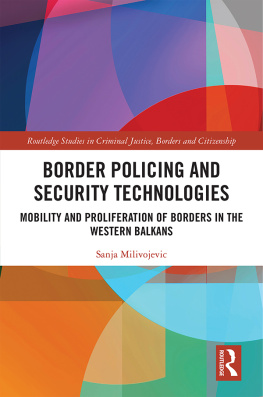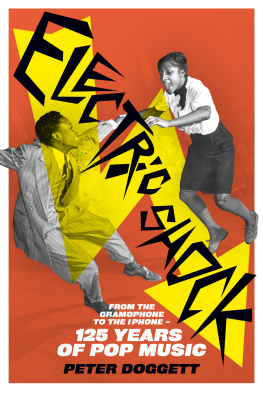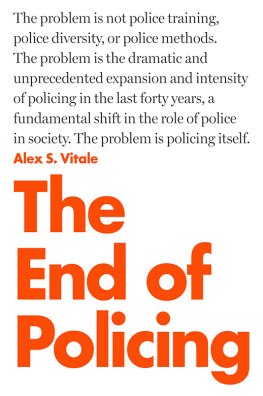
The care with which police approach the use of force whether lethal or less than lethal is one of the most important measures of the quality of policing. Dr Dymond has produced the first significant analysis of the adoption and development of the use of the TASER. Her careful blending of the policy, theory and her own primary research provides a seminal study that deserved to be read by practitioners, policy makers and students of policing. A recommended read
Peter Neyroud,
Associate Professor in the Jerry Lee
Centre for Experimental Criminology,
Institute of Criminology,
University of Cambridge.
This thought provoking book provides a much-needed critical look at the use of electric-shock weapons and police use of force, as well as careful, well-considered policy recommendations and constructive challenge to all of us working in this area. Eschewing simplistic answers, and delving into the complexity of such topics, it makes a significant contribution to our understanding of the risks evident in poorly developed systems and how these can be mitigated against through robust policing professional standards. As a human rights practitioner, this book could not come at a more critical moment.
Oliver Feeley-Sprague,
Amnesty International UKs Military,
Security and Police Programme Director.
Abi Dymonds long-standing and deep interest and experience in the use of conducted energy weapons is reflected in this book which encompasses her personal view of Taser, its use and implications. It is very widely referenced, and uses an extensive and enlightening range of information sources. As such it should be read by all those with an interest in this increasingly challenging field, whether from a law-enforcement, legal, medical, scientific or human rights background.
Jason Payne-James,
Specialist in Forensic & Legal Medicine,
Consultant Forensic Physician
Electric-Shock Weapons, Tasers and Policing
Building on five years of research, and drawing on criminology, science and technology studies (STS), socio-legal studies and social psychology, this book is the first non-medical book written on electric-shock weapons, of which the best well known is the TASER brand.
The polices ability to use force is one of their most crucial powers, yet one that has been relatively neglected by criminology. This book challenges some of the myths surrounding the use of these weapons and considers their human rights implications and impact on members of the public and officers alike. Drawing on STS, it also considers the role and impact of electric-shock technologies, examines the extent to which technologies and non-human agency may also play a role in shaping officer decision making and discretion, and contributes to long standing debates about police accountability.
This is essential reading for policing scholars around the world, particularly those engaged with use of force, culture and accountability, as well as those engaged with Science and Technology studies.
Abi Dymond is a Senior Lecturer in Criminology in the Sociology, Philosophy and Anthropology Department at the University of Exeter and was previously an ESRC Future Research Leader. Prior to joining academia, she worked for over ten years for various human rights and international development NGOs, including the Omega Research Foundation. Impact is a large part of Abi's work. She won the ESRC Celebrating Impact Award in 2018 for her work on use of force, received travel costs from Taser International in 2014 to present her research to their Senior Management Team and regularly engages in a number of other impact activities in the UK and internationally.
Routledge Studies in Policing and Society Series Editors Jenny Fleming, University of Southampton, UK Jennifer Wood, Temple University, USA
Routledge Studies in Policing and Society aims to establish an inter-disciplinary, international intellectual space of original contributions to either classic or emerging debates about the nature and effects of policing in society. The works in this series will advance our theoretical, methodological and/or empirical knowledge of policing in various societies across the world. It is the hope of the series editors that the works in this series will help fill gaps in our global understanding of policing and society.
Criminal Futures
Predictive Policing and Everyday Police Work
Simon Egbert and Matthias Leese
Women Police in Contemporary China
Gender and Policing
Anqi Shen
Electric-Shock Weapons, Tasers and Policing
Myths and Realities
Abi Dymond
First published 2022
by Routledge
2 Park Square, Milton Park, Abingdon, Oxon OX14 4RN
and by Routledge
605 Third Avenue, New York, NY 10158
Routledge is an imprint of the Taylor & Francis Group, an informa business
2022 Abi Dymond
The right of Abi Dymond to be identified as author of this work has been asserted by her in accordance with sections 77 and 78 of the Copyright, Designs and Patents Act 1988.
The Open Access version of this book, available at www.taylorfrancis.com, has been made available under a Creative Commons Attribution-Non Commercial-No Derivatives 4.0 license.
Trademark notice: Product or corporate names may be trademarks or registered trademarks, and are used only for identification and explanation without intent to infringe.
British Library Cataloguing-in-Publication Data
A catalogue record for this book is available from the British Library
Library of Congress Cataloging-in-Publication Data
A catalog record has been requested for this book
ISBN: 978-0-367-43387-1 (hbk)
ISBN: 978-1-032-13459-8 (pbk)
ISBN: 978-1-003-00286-4 (ebk)
DOI: 10.4324/9781003002864
Typeset in Bembo
by KnowledgeWorks Global Ltd.
For my wonderful family, both human
(Gill, Martin, Keira and Matt) and non-human
(Kanga, Baloo and Skye), with thanks.
Contents
- 2Technologies, tools, and TASERs
- 3Better stunned than gunned? Origin myths and mission creep
- 4A nicer weapon? Projectile electric-shock weapons and public safety
- 5Theres nothing bad I can say about TASER: TASER and officer safety
- 6Theres no right or wrong: Laws, policies and training
- 7Just a tool: Revisiting human and non-human agency
- 8You cannot obtain accountability: Officer accountability for use of force
- 9Conclusion
- 2 Technologies, tools, and TASERs
- 3 Better stunned than gunned? Origin myths and mission creep
- 4 A nicer weapon? Projectile electric-shock weapons and public safety
- 5 Theres nothing bad I can say about TASER: TASER and officer safety
- 6 Theres no right or wrong: Laws, policies and training
- 7 Just a tool: Revisiting human and non-human agency
- 8 You cannot obtain accountability: Officer accountability for use of force
- 9 Conclusion
Acknowledgements
Id like to start by thanking all the research participants and those in the three police forces, NPCC (previously ACPO) and the College of Policing who facilitated access and/or assisted with the research. For reasons of confidentiality they will remain nameless, but I trust they know who they are, and that they are appreciated. A particularly harrowing part of the research was attending inquests into the deaths of two young menJordan Lee Begley and Marc Anthony Colefollowing police use of force, including TASER. I would like to thank the staff who made it possible to attend and I am humbled and saddened at the opportunity to do so.








